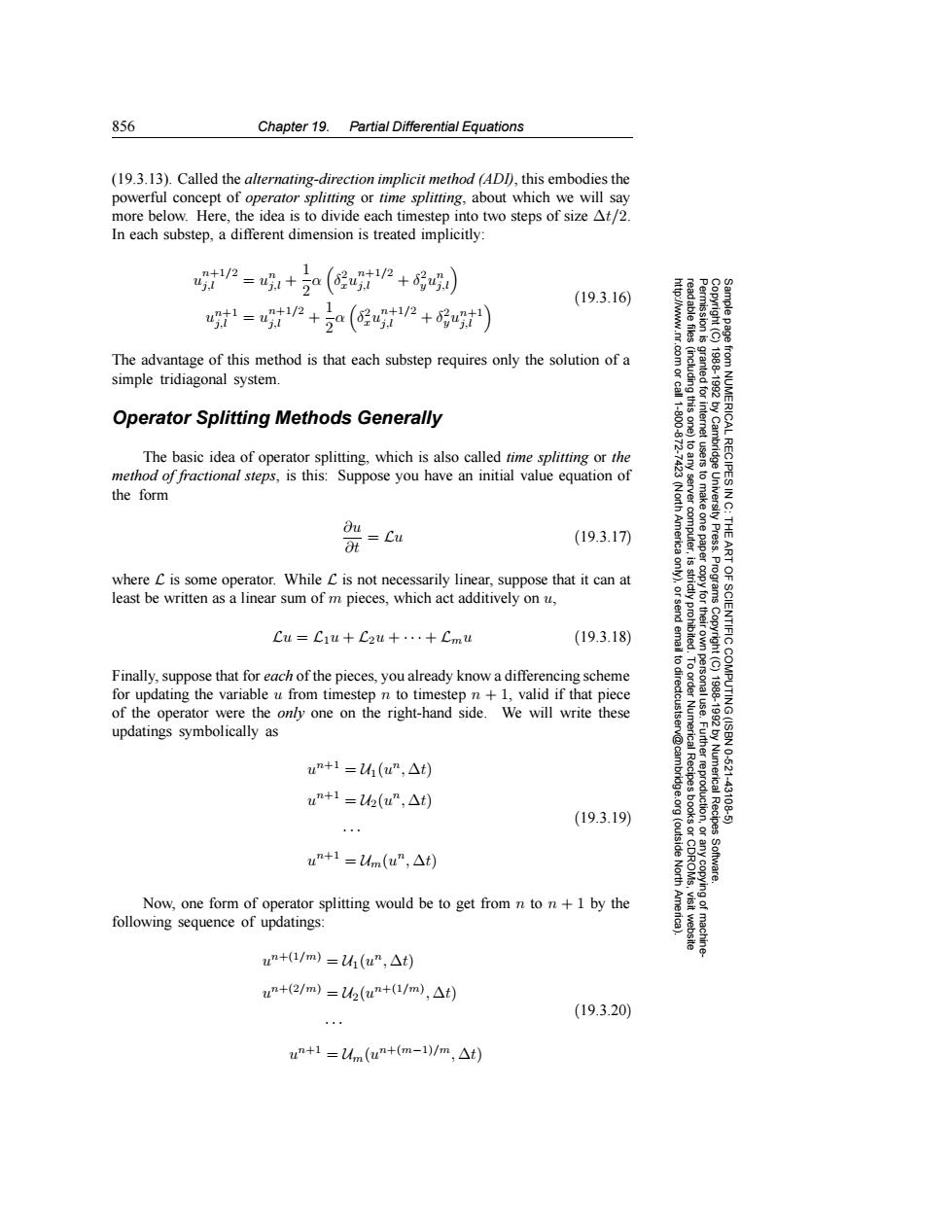正在加载图片...

856 Chapter 19.Partial Differential Equations (19.3.13).Called the alternating-direction implicit method (ADI),this embodies the powerful concept of operator splitting or time splitting,about which we will say more below.Here,the idea is to divide each timestep into two steps of size At/2. In each substep,a different dimension is treated implicitly: 啦=喷+(医时P+ (19.3.16) 时=e+(G2+y') The advantage of this method is that each substep requires only the solution of a simple tridiagonal system. Operator Splitting Methods Generally 行 The basic idea of operator splitting,which is also called time splitting or the method of fractional steps,is this:Suppose you have an initial value equation of the form g.af 2 =Cu (19.3.17) Ot where C is some operator.While C is not necessarily linear,suppose that it can at 4、● 9 least be written as a linear sum of m pieces,which act additively on u, Cu=C1u+C2u+…+Cmu (19.3.18) Finally,suppose that for each of the pieces,you already know a differencing scheme for updating the variable u from timestep n to timestep n+1,valid if that piece of the operator were the only one on the right-hand side.We will write these updatings symbolically as un+1=l4(n,△t) Numerical 10521 un+1=2(u”,△t) 431 (19.3.19) (outside Recipes un+1=lun(u”,△t) North Software. Now,one form of operator splitting would be to get from n to n+1 by the following sequence of updatings: un+(1/m)=4(u”,△t) un+(2/m)=u(un+(1/m),At) (19.3.20) n+1=4n(un+(m-1)/m,△t)856 Chapter 19. Partial Differential Equations Permission is granted for internet users to make one paper copy for their own personal use. Further reproduction, or any copyin Copyright (C) 1988-1992 by Cambridge University Press. Programs Copyright (C) 1988-1992 by Numerical Recipes Software. Sample page from NUMERICAL RECIPES IN C: THE ART OF SCIENTIFIC COMPUTING (ISBN 0-521-43108-5) g of machinereadable files (including this one) to any server computer, is strictly prohibited. To order Numerical Recipes books or CDROMs, visit website http://www.nr.com or call 1-800-872-7423 (North America only), or send email to directcustserv@cambridge.org (outside North America). (19.3.13). Called the alternating-direction implicit method (ADI), this embodies the powerful concept of operator splitting or time splitting, about which we will say more below. Here, the idea is to divide each timestep into two steps of size ∆t/2. In each substep, a different dimension is treated implicitly: un+1/2 j,l = un j,l + 1 2 α δ2 xun+1/2 j,l + δ2 yun j,l un+1 j,l = un+1/2 j,l + 1 2 α δ2 xun+1/2 j,l + δ2 yun+1 j,l (19.3.16) The advantage of this method is that each substep requires only the solution of a simple tridiagonal system. Operator Splitting Methods Generally The basic idea of operator splitting, which is also called time splitting or the method of fractional steps, is this: Suppose you have an initial value equation of the form ∂u ∂t = Lu (19.3.17) where L is some operator. While L is not necessarily linear, suppose that it can at least be written as a linear sum of m pieces, which act additively on u, Lu = L1u + L2u + ··· + Lmu (19.3.18) Finally, suppose that for each of the pieces, you already know a differencing scheme for updating the variable u from timestep n to timestep n + 1, valid if that piece of the operator were the only one on the right-hand side. We will write these updatings symbolically as un+1 = U1(un, ∆t) un+1 = U2(un, ∆t) ··· un+1 = Um(un, ∆t) (19.3.19) Now, one form of operator splitting would be to get from n to n + 1 by the following sequence of updatings: un+(1/m) = U1(un, ∆t) un+(2/m) = U2(un+(1/m) , ∆t) ··· un+1 = Um(un+(m−1)/m, ∆t) (19.3.20)